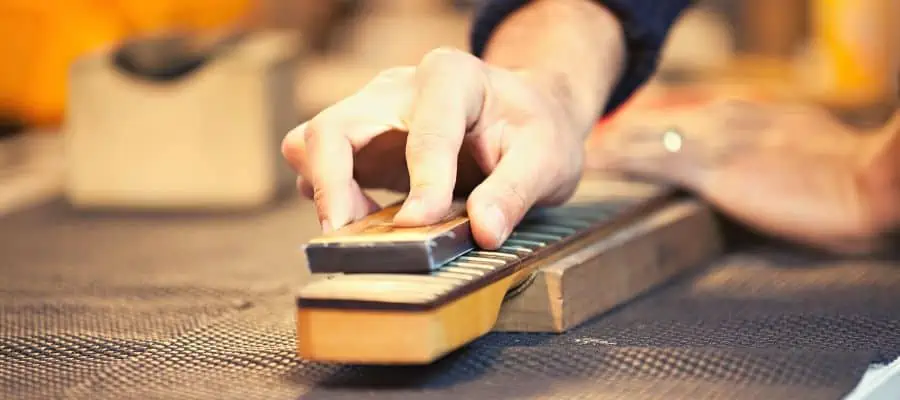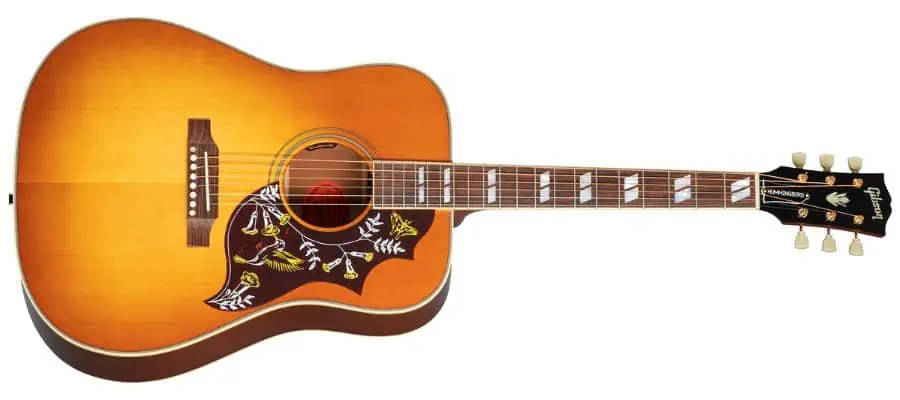When it comes to creating top-of-the-line instruments, Gibson and Martin are the names that will most likely pop up first in the guitarist’s mind. For guitar enthusiasts, the Gibson Hummingbird and Martin D28 are iconic instruments that have stood the test of time. Picking between the two can be challenging since both are renowned for their exceptional sound and excellent artistry.
One of the key differences between these guitars is their construction and hardware. The Hummingbird has a solid Sitka spruce top with mahogany back and sides, while the D28 has a solid Sitka spruce top with East Indian rosewood back and sides. This gives the Hummingbird a warmer, more mellow sound, while the D28 has a brighter, more balanced sound.
Considering the tone that Hummingbird produces, this makes it well-suited for strumming and fingerpicking, and it’s particularly popular among folk and country musicians. The Martin D28, on the other hand with a brighter, more balanced sound with a strong low end and clear highs making it a versatile guitar that can handle a variety of playing styles and genres.
| Gibson Hummingbird | Martin D28 | |
| Body Shape | Square Shoulder Dreadnought | Dreadnought |
| Body Wood | Sitka Spruce, Mahogany | Sitka Spruce, Solid East Indian rosewood |
| Neck Shape | Round profile | Modified low oval |
| Neck Wood | Mahogany | Select hardwood |
| Neck Construction | Set neck | Dovetail |
| Fretboard Material | Rosewood | Ebony |
| Scale Length | 24.75” | 25.4” |
| Number Of Frets | 20 | 20 |
| Frets Material | Nickel | Nickel |
| Type of Bridge | Fixed | Fixed |
| Tuning Machines | Grover Rotomatics | Nickel open-gear |
| Weight | 4.5 – 5.5 lbs (2.04 – 2.49 kg) depending on the model | 4.5 – 5.5 lbs (2.04 – 2.49 kg) depending on the model |
Renowned musicians such as Bob Dylan, Elvis Presley, and Keith Richards have played both guitars, which boast of significant heritage. Choosing between the Gibson Hummingbird and Martin D28 can be a difficult decision, as both guitars are known for their exceptional sound and quality craftsmanship.
Construction & Hardware Compared

The Gibson Hummingbird and Martin D28 are both built with high-quality materials and craftsmanship. The Gibson Hummingbird features a square-shoulder dreadnought body shape with a mahogany back and sides and a Sitka spruce top. The neck is made of mahogany and features a round profile, while the fretboard is made of rosewood. The bridge is traditionally belly up and is made of rosewood. The tuning machines are Grover Rotomatics, which are known for their precision and stability.
On the other hand, the Martin D28 features a dreadnought body shape with a solid East Indian rosewood back and sides and a Sitka spruce top. The neck is made of select hardwood and features a modified low oval profile with a high-performance taper. The fretboard is made of ebony, and the bridge is ebony belly-style with a drop-in saddle. The tuning machines are nickel open-gear tuners with butterbean knobs.
While both guitars are made with high-quality materials, the construction and hardware differ slightly. The Gibson Hummingbird features a set neck construction, while the Martin D28 features a simple dovetail neck joint. The Martin D28 also features a bone nut and saddle,.
Tone Compared

When it comes to tone, the Hummingbird and D28 have distinct differences that are worth noting. The Gibson Hummingbird has a warm and mellow sound with a strong midrange and a slightly scooped low end. This makes it ideal for fingerpicking and strumming, and it’s particularly popular among folk and country musicians. The mahogany back and sides contribute to the warm tone, while the solid Sitka spruce top adds brightness and clarity to the sound.
In contrast, the Martin D28 has a more balanced sound with a strong low end and clear highs. It’s a versatile guitar that can handle a variety of playing styles and genres. The East Indian rosewood back and sides contribute to the deep bass response, while the solid Sitka spruce top provides clarity and projection.
The Hummingbird’s warm and mellow tone makes it a great choice for singer-songwriters and solo performers, as it provides a rich and full sound that doesn’t overpower vocals. On the other hand, the D28’s balanced tone makes it a great choice for playing with a band or in a recording studio, as it can cut through a mix and provide a strong foundation for other instruments.
Feel & Playability Compared

The Gibson Hummingbird has a slightly slimmer neck profile compared to the Martin D28, which may make it a more comfortable option for players with smaller hands. The Hummingbird also features a larger body than the D28, which can make it feel a bit more cumbersome to play for some players, particularly those who are used to smaller-bodied instruments.
On the other hand, the Martin D28 has a slightly wider neck profile, which can make it a more comfortable option for players with larger hands. It also has a longer scale length, which can make it feel more responsive and dynamic, particularly for players who prefer a more nuanced playing style.
Both guitars are well-built and offer exceptional playability. The Hummingbird’s larger body may require more effort to play for some players. The D28’s slightly smaller body can provide a more comfortable playing experience but may lack some of the depth and resonance of the Hummingbird.
Looks Compared
Comparing the looks of the guitar and answering which one is better based on the looks is difficult questions to answer simply because everyone will have their preference and will find some feature of the instrument more soothing to their eyes.

When it comes to aesthetics, both the Hummingbird and D28 are stunning instruments. The Hummingbird features a distinctive pickguard with a hummingbird design, while the D28 has a more understated appearance with a simple pickguard.

The Hummingbird also has more ornate inlay work on the fretboard and headstock, while the D28 has a more traditional and simple look. Ultimately, the choice between the two guitars may come down to personal preference in terms of aesthetics.
Conclusion
To sum up, both the Gibson Hummingbird and Martin D28 are excellent guitars with their own unique qualities and strengths. Choosing between them depends on individual preferences, playing style, and intended use.
If you’re seeking a guitar with a full and rich tone, and are comfortable with a slightly larger body, then the Gibson Hummingbird might be the right choice. Conversely, if you value comfort and a more responsive playing experience, then the Martin D28 may be the better option.
However, both of these guitars are renowned instruments that have been cherished by musicians for many years. They are both expertly constructed with exceptional playability and sound that will endure for years. Ultimately, the best way to decide between the two is to test them out for yourself and choose the one that resonates with you.
If you found this article useful, you may want to save this pin below to your Guitar board.

Recent Posts
When learning new songs have you noticed that some of the chord sequences sound really good? But when you tried to come up with your own chord sequence, or as we call it chord progression, you found...
Some guitarists insist on buying an expensive amplifier with their electric guitar. They assume that this is a must for every type of guitarist out there. However, in some situations, this isn’t...

